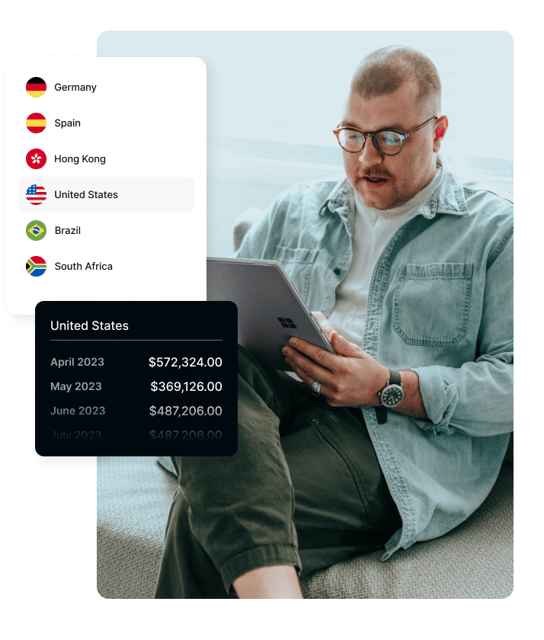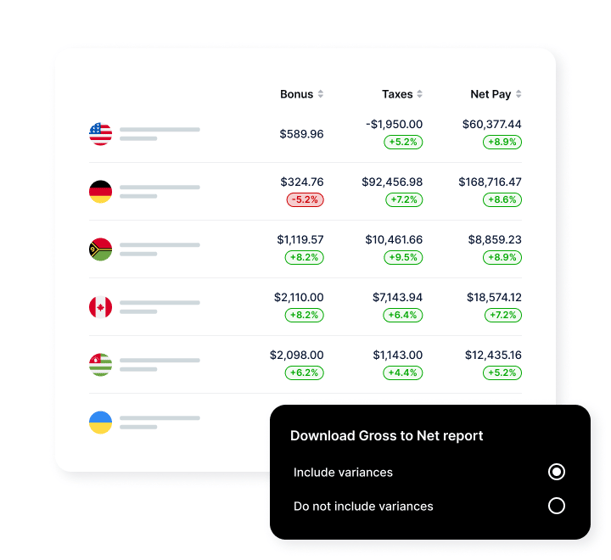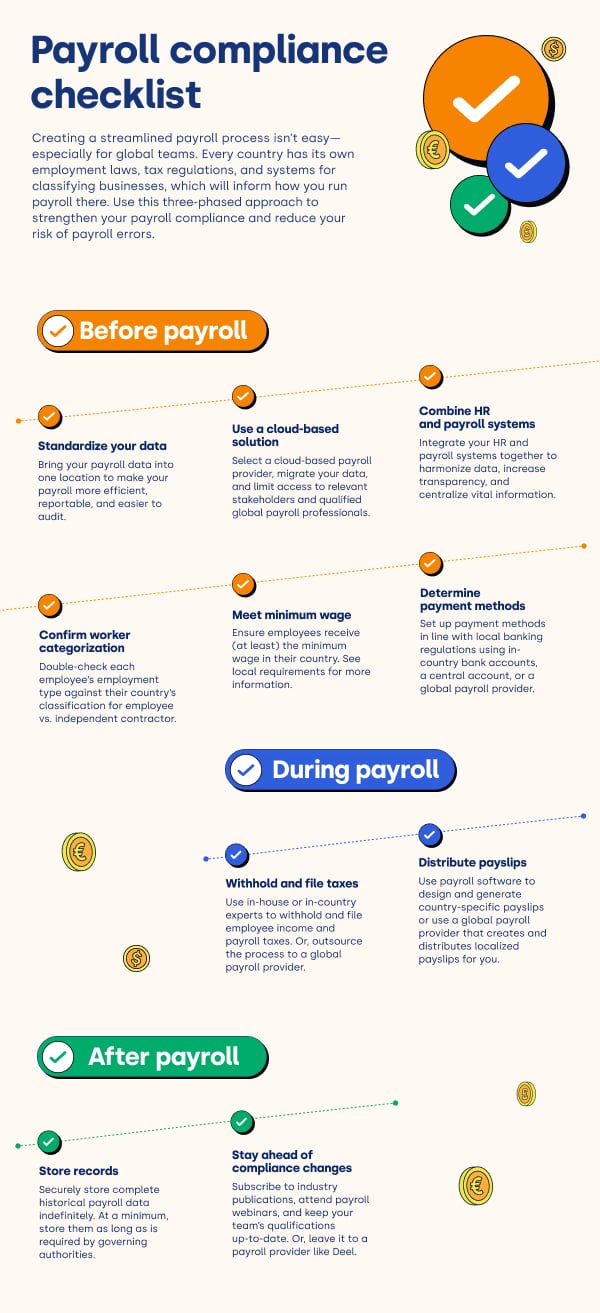
12 Payroll Best Practices to Implement in 2024
Key takeaways
- Payroll teams should prioritize data protection and security in 2024, especially if their organization plans on hiring and paying international employees.
- Organizations should have a trusted source they can use to confirm worker classification.
- For scaling businesses, two of the best practices for establishing a payroll system are to automate or outsource your processes.
The ideal payroll process is simple, bolsters compliance efforts, and provides employees with a positive end-to-end experience. But how do you get there? A great first step is to follow the latest payroll best practices.
In this article, we explore some of the payroll best practices you can implement in 2024 to improve your team’s payroll functions.
Disclaimer: This content is based on US payroll processes—refer to your local payroll laws for guidance. This article is for informational purposes only and is not intended as legal or tax advice.
1. Create payroll policies and procedures for the entire payroll system
The foundation of any good process—especially one as complex as payroll—are the procedures and policies. Creating a single source of truth for your payroll processes and best practices will ensure your entire payroll department is working with the same standards in mind.
Your payroll policies should cover:
- Components of payroll
- Payment schedule
- Payment methods
- Payroll deductions
- Benefits
- And more
Your payroll procedures should cover:
- Data entry processes
- Report handling standards
- Payment processes
- Record keeping standards
- Calculation processes
- Pre-payroll preparations
- Post-payroll reporting process
To get started, you can use a global payroll template to identify day-to-day payroll tasks and how much each worker will get paid for a single pay cycle.
Note: Payroll laws (such as when and how employees must be paid) vary by country. Refer to your local laws and regulations for more information.
How EMF Media cut their time spent on payroll admin by 50%
EMF Media operates like a growth incubator for startups and brand-builders across Europe. Before Deel, they were using five different platforms in order to accommodate the different payment requirements for each contractor.
Payroll was messy, and the team would spend hours on end working to get everyone paid on time. It was a very decentralized process, and they had to have multiple bank accounts in order to pay their team.
Since centralizing their payroll with Deel, they’ve reduced their workload significantly and can accommodate their contractors' payment options with ease.
With Deel, the team has onboarded 48 contractors across 15 different countries and cut 50% of the time spent navigating different platforms and manual process from onboarding to payroll.
Not only have they been able to allocate those resources elsewhere, but it’s also given them the tools and flexibility they need to scale.
2. Pencil in important dates and deadlines for payroll processing for the entire year
One of the upsides of managing payroll is that almost all of the necessary deadlines are known beforehand. Incorporate this strategic planning into your payroll department’s schedule to avoid payroll mistakes and Internal Revenue Service (IRS) penalties.

Deadlines and important dates may include but are not limited to:
- Paydays (weekly, bi-weekly, semi-monthly, or monthly)
- Federal Reserve closed dates
- Local banks closed dates
- IRS deadlines to file and furnish tax forms
3. Set up notifications for deadlines
Small business owners and payroll team leaders at enterprise companies can equally benefit from setting payroll and tax deadline reminders. Deadlines will vary depending on your country’s payroll laws and your payroll schedule.
How and where you set up notifications depends on your team and the tools you use. Automating reminders in a collaborative tool you already use on a daily basis, such as Slack, is one of the simplest ways to ensure notifications are received. Or, create a payroll calendar in your team’s shared Google Calendar and invite all required payroll team members to the events throughout the year.

4. Ensure your workers are classified correctly
Understanding employee classification is required to run payroll correctly. You need to know the difference between full-time employees and independent contractors and exempt and non-exempt employees in order to collect and file the right forms, pay workers correctly, and provide employees with their legally-required benefits.
Employers pay much more for employees than for independent contractors because of the benefits and payroll taxes they sponsor for each employee. When employers misclassify their workers, they avoid federal and state taxes, such as unemployment taxes and Medicare taxes, which leads to a substantial loss of tax revenue.
If your team hires independent contractors as well as employees, double-check they’re classified correctly. You can follow this assessment to determine your risk of misclassification.
5. Revise and automate your payroll system
One of the biggest advancements in human resources software is payroll processing automation. Automated and digitized solutions can help you manage the payroll department’s workload and improve payroll compliance and payroll tax filing, taking over tasks such as:
- Timekeeping
- Calculating overtime, bonuses, and raises
- Payroll reporting and cost breakdowns
- Calculating taxes and deductions
- Tax filing
Confused by global payroll management?

6. Use real-time data tracking and analysis
Payroll teams can’t make informed decisions based on outdated data. Whether you’re reviewing employee payroll information or a cost breakdown of your US Social Security contributions, you need an up-to-date report. Deel’s Global Payroll platform, for example, provides a global view of all your payroll data, so you can make data-driven decisions about payroll with reports from all locations and roles.

7. Create a strict payroll approval process
The payroll approval process usually takes a lot of time, but it also requires simultaneous and quick participation of several employees of various rankings. So how can you make this process simpler?
First, be aware of your budget, schedules, pay periods, and other limitations. Then, set guidelines that state any staffing strategy, promotion, or personnel change needs to be previously approved so you won’t face any major payroll issues further on in the process.
8. Offer more accessible payment options
Setting up direct deposit payments that go directly to employees’ bank accounts, instead of sending paper checks, is the first step to improving your payroll processes in 2024. If you want to elevate your workers’ payment experience further, or if you have a global team that includes independent contractors, you may be looking for more flexible solutions.
Workers using Deel can withdraw their pay in Cryptocurrency. According to Deel Lab’s State of Global Hiring Report, 4% of all withdrawals made through Deel were in Crypto in 2022. Companies using Deel can also pay contractors early using Deel Advance.
How 1840 & Company aided their distributed workforce in the aftermath of Super Typhoon Rai with Deel
1840 & Company is a global marketplace for companies to scale and accelerate growth with vetted freelancers and outsourcing services.
In December 2021, Super Typhoon Rai hit Cebu City in the Philippines, directly impacting an integral portion of the company’s workers who needed immediate help. In response, Bryan DiGiorgio, CEO and Founder of 1840 & Company, used Deel to send advanced payments to his workers in just a few clicks.
“Without Deel, our desire and capability to help would have taken several days or more; a lifetime for those impacted,” said DiGiorgio. “It was very fulfilling on a personal basis to make these humanitarian decisions and have it provide immediate help—halfway across the world.”
Deel clients can also provide contractors with a Deel Card, enabling them to spend funds directly from their Deel balance without sending their money back to their bank. It’s a great option for those working in countries like the Philippines to get their paycheck in a more stable currency.
9. Look for a software solution with mobile self-service
Using a payroll platform with self-service functions takes repetitive tasks off your HR team’s plate and allows them to focus on core initiatives. Self-service enables employees to perform simple tasks themselves, such as submitting timekeeping information, reviewing past and current pay stubs, and submitting tax information.
Using a platform that has self-service and is mobile-friendly is ideal, as employees and payroll professionals can access the platform anytime and anywhere, creating a better user experience and increasing efficiency.
10. Implement a strong data protection policy
Whether you’re storing your data online, using payroll software, or outsourcing payroll services, you need to think about your data security. Payroll teams work with sensitive employee data, such as banking information and employee records. Therefore, you need to take precautionary measures to keep that information secured.
Cloud-based solutions are typically the safest option for many businesses, but it’s up to you to determine what works for your company and data. You also need to have a proper data processing agreement (DPA) in place if you choose to work with an outsourced payroll service provider.

11. Outsource your payroll for more expertise and coverage
Eventually, many companies reach the point where outsourcing payroll is the most resource-effective payroll management solution. For some, it’s because their workforce has grown too large for their internal payroll team to manage alone. Other companies turn to payroll outsourcing when they begin to hire employees internationally.
If your leadership team has global expansion planned for 2024, it’s time to consider transitioning to an outsourced payroll provider. The benefits of outsourcing certain payroll tasks include:
- Reduced costs
- Time saved
- Access to expertise
- Improved employee experience
- Increased data security and compliance protection
12. Ask your employees for honest and constructive feedback
Employees are on the receiving end of the payroll process, and their input can help you improve the entire experience. Use pulse surveys to gauge your team’s satisfaction with your current payroll process and system. What issues have they experienced that your payroll department may not be aware of? Do they feel they’re getting paid quickly and easily enough? What can you do to improve their payment experience?
Alex Bouaziz, Co-founder and CEO, Deel
Frequently asked questions about how to manage payroll
Learn the basics of payroll management here.
What are the six steps in managing a payroll system?
Although each company has its own system of running payroll, how payroll works is universal:
- Collect the Employer Identification Number (EIN), employees’ Tax Identification Numbers (TIN), and all the accompanying financial information and appropriate tax forms
- Choose and set up your payroll schedule
- Calculate employees’ gross pay
- Deduct income tax, social security, healthcare, and other deductions as per local laws
- Pay employees their net pay
- Securely store payroll records for quarterly tax filing and in case of legal disputes or audits
Read our complete guide on how payroll works for more payroll advice.
What are the four steps of running payroll remotely?
If you manage payroll for a remote team, you need to ensure a smooth and compliant payroll process that adheres to international laws. The four primary steps of running global payroll are similar to a standard payroll process:
- Classify workers correctly (employee vs. independent contractor)
- Choose your payroll methods (in-house manual/automated or local/global outsourcing)
- Gather your team’s tax forms
- Choose your payment methods
Learn more about how to set up and run global payroll for a remote team.
What are the best payroll practices for maintaining compliance?
Fewer than two-thirds of payroll professionals agree or strongly agree they have all the tools and expertise needed to manage compliance. To maintain compliance in the US, payroll teams need to follow state, federal, and international laws.
Follow our payroll compliance checklist for 2024 to improve payroll management compliance on your team.
Streamline your payroll with one global platform
If you have international workers, you probably already know how complex global payroll is. But making international payments shouldn’t stop you from having a global team.
With Deel, you can fund payroll with just a click and automatically calculate payroll taxes without lifting a finger. Our multiple currency options and various withdrawal methods make it even easier for your team to get paid on time, every time, in 90+ countries.
|
Competitors |
|
Deel |
|
Most only offer bank transfers and direct debit or credit card |
Funding methods |
10+ funding methods for clients |
|
Most only offer bank transfers |
Withdrawal options |
7+ withdrawal options for contractors |
|
No competitor offers a physical contractor’s card |
Contractor’s card |
Physical and digital contractor’s cards |
|
Some of them offer advanced payments but at a high cost |
Advanced payments |
Advanced payments through Deel Advance |
|
Most of our competitors don’t provide Global Payroll services, which makes their solutions less scalable |
Scalability |
Contractor payments, EOR, and Global Payroll in one platform |
Learn more about Deel’s Global Payroll solution today.



